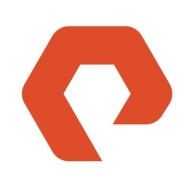


NetApp StorageGRID and MinIO are prominent competitors in the object storage solutions category. While both have significant strengths, NetApp StorageGRID appears to have an upper hand with its enterprise-grade features like fast data backup and recovery, integrated lifecycle management, and strong niche market presence, particularly in Canada.
Features: NetApp StorageGRID's notable features include fast data backup and recovery via AltaVault, effective deduplication and compression, and integrated Information Lifecycle Management for seamless data operations. MinIO shines with its on-demand tenant deployment, erasure coding, and robust API, ensuring flexible data management and compatibility with various storage types.
Room for Improvement: NetApp StorageGRID users suggest enhancements in menu logic, storage efficiency, and metadata handling. Improved pricing strategies and easier initial setup are also desired. MinIO could refine its user interface, enhance documentation, and improve multi-tenancy support. Both platforms could benefit from enhanced monitoring capabilities.
Ease of Deployment and Customer Service: StorageGRID offers solid deployment options focused on on-premises and private cloud with reliable support, though expertise concerns exist. MinIO’s deployment is simplified due to its open-source nature, but recommendations for improved customer support and feature enhancements are prevalent.
Pricing and ROI: NetApp StorageGRID features enterprise-grade pricing, offering long-term cost savings and efficiency suitable for large-scale deployments. MinIO’s open-source model offers a cost-effective solution for smaller deployments, although enterprise support incurs additional costs.
| Product | Market Share (%) |
|---|---|
| MinIO | 17.9% |
| Pure Storage FlashBlade | 5.7% |
| NetApp StorageGRID | 5.8% |
| Other | 70.6% |



| Company Size | Count |
|---|---|
| Small Business | 11 |
| Midsize Enterprise | 11 |
| Large Enterprise | 21 |
| Company Size | Count |
|---|---|
| Small Business | 11 |
| Midsize Enterprise | 4 |
| Large Enterprise | 9 |
| Company Size | Count |
|---|---|
| Small Business | 5 |
| Midsize Enterprise | 4 |
| Large Enterprise | 11 |
FlashBlade is the industry’s most advanced scale-out storage for unstructured data, powered by a modern, massively parallel architecture to consolidate complex data silos (like backup appliances and data lakes) and accelerate tomorrow’s discoveries and insights.
MinIO is an open-source object storage system. It is designed to efficiently store and retrieve unstructured data, such as photos, videos, and backups. MinIO can be used as a standalone object storage server or as part of a larger system, such as a data lake or a private cloud, and can be deployed on-premise, in the cloud, or in a hybrid environment, making it a flexible storage solution for a variety of use cases.
MinIO’s features include erasure coding, bitrot protection, and checksum validation, which help ensure data integrity and reliability. The solution’s multi-tenancy support makes it ideal for multi-user environments. MinIO’s edge computing tools enable data storage and processing closer to users' locations, reducing latency and improving performance. MinIO can easily scale to accommodate storage and power demands, making it ideal for use in large-scale, data-intensive environments.
MinIO Benefits and Features:
MinIO offers several key benefits and features for organizations looking for a scalable and high-performing object storage solution:
Reviews from Real Users
MinIO stands out among its competitors for a number of reasons. Several major ones are its flexibility, integration options, and performance.
Süleyman Fazıl Y., a senior software engineer at a tech services company, writes, “The most valuable features are that MinIO is open, it works on-premise, and is compatible with the Amazon industry which is great for finding compatible libraries in many languages which is very good for developers.”
Rebecca S., CTO at NIASE, says, “MinIO is much improved over the prior solution, updates are simple to apply, and we anticipate that future capacity requirements will be easier to meet. Our customers are using this solution to retrieve tens of thousands of objects (documents and files) per hour, and MinIO seems to be able to keep up with it.”
Store and manage unstructured data at scale using NetApp StorageGRID for secure, durable object storage. Place content in the right location, at the right time, and on the right storage tier, optimizing workflows and reducing overall costs for globally distributed rich media.
We monitor all File and Object Storage reviews to prevent fraudulent reviews and keep review quality high. We do not post reviews by company employees or direct competitors. We validate each review for authenticity via cross-reference with LinkedIn, and personal follow-up with the reviewer when necessary.